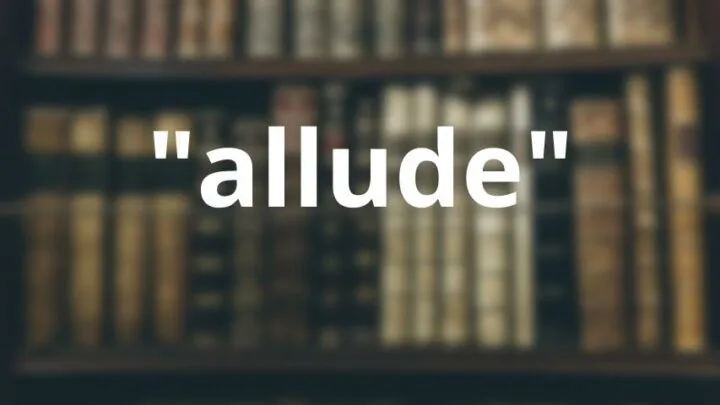In the beginning, there was the word.
What word, you might ask? And is this a biblical word, like when you tell someone to turn the other cheek?
In fact, the word in this case is “allude,” and that opening sentence is an example of allusion, a type of reference to other texts or situations.
How do you use allude in a sentence?
Allude is a transitive verb that means “to refer to.” Although the meaning is slightly different, the easiest way to use allude in a sentence is to place it where you would put the verb “refer.” You can also use “allude” to discuss a specific type of literary or artistic reference called allusion.
The meaning of “allude”
The word “allude” is a near-synonym for “refer,” although it typically means in indirect reference rather than an explicit one.
Despite the slight difference in meanings, the fact that “allude” and “refer” are so similar makes it easy to figure out the meaning of “allude.”
In nearly all cases, you can simply take this word to mean “refer.”
Allude: parts of speech and grammatical rules
Allude is a verb, or action word. Specifically, it’s a transitive verb.
You can read our article on transitive verbs if you aren’t sure what that means, but the short version is that every time you use “allude” there needs to be an object attached.
This is the basic grammatical rule for “allude,” and so long as you remember it, you’ll be in good shape.
If, on the other hand, you do want to use “allude” without going into more detail, you can reach for “to make an allusion” instead.
Allusion is the noun form of allude and using it as a noun phrase doesn’t require an object or any additional grammar.
In other words, you always have to allude to something–you can’t just allude. But you can say you’re making an allusion without having to specifically say what it’s an allusion to.
How to use “allude” with a specific reference
As noted above, to use “allude” in a sentence, all you really need to do is put the word where you would put “refer.”
More specifically, this verb nearly always needs to be followed by the word “to” and the reference to which you are alluding.
Note that the previous sentence, which seems to break that rule, has “to which” at the start of the clause that includes “allude,” so it still fits the pattern. (If you don’t understand why, read our article on how to use “in which” in a sentence.)
This rule holds no matter what tense the verb “allude” is in, as well.
So whether someone is alluding to something or has alluded to something, you still need to include that “to” and the reference.
Let’s take a look at some examples of how to use allude in a sentence.
Example Sentences
In this case, the president is referencing something from her own past rather than a specific text.
Remember that “allude” is typically used for indirect references, as well, so if she explicitly discussed her time as a CEO the phrase “referred to” might be a better choice.
Here, “allude” describes someone’s reaction to a show that makes constant references to the books it is based on.
How to use “allude” without a specific reference
Again, “allude” is a transitive verb. That means a sentence that says “He alluded throughout his speech” makes no sense.
If you just want to say someone was alluding to something, you can always say “He alluded to things throughout his speech,” but sometimes you really just want to point out the action rather than describing it in detail.
The simplest solution is to use the verb phrase “make allusions” if you want to describe an action. Alternatively, you can say the speech was “filled with allusions.”
Example Sentences
Wilhelm: “I could stop, Mr. Bond. But then I’d have to kill you.”
Sam: “Is that another allusion to something? Ugh!”
In this dialogue, Sam uses “making allusions” to draw attention to them, rather than using the verb “allude.”
The sentence “Stop alluding to so many things!” would be identical in meaning.
Note that, although you don’t have to include “to” after the word allusion, you can if you need to be specific.
For instance, the sentence “The book made an allusion to the Bible” is grammatical.
What is an allusion?
Now that we’ve covered how to use allude in a sentence, you might be wondering what an allusion is.
This word comes from the Latin word allusio, which means “to play on words.” More generally, though, the meaning is the same as described above.
An allusion is a reference in literature, poetry, or other art form to something outside of the piece of art in which it is contained.
Of course, you don’t need a degree in literature to make an allusion or to use allude in a sentence, so if this is confusing your best bet is to keep treating the word as though it says “refer.”

Hey fellow Linguaholics! It’s me, Marcel. I am the proud owner of linguaholic.com. Languages have always been my passion and I have studied Linguistics, Computational Linguistics and Sinology at the University of Zurich. It is my utmost pleasure to share with all of you guys what I know about languages and linguistics in general.

